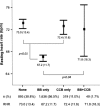Differential effect of β-blockers for heart rate control in coronary artery disease
- PMID: 22083944
- PMCID: PMC6652363
- DOI: 10.1002/clc.20981
Differential effect of β-blockers for heart rate control in coronary artery disease
Abstract
Background: Resting heart rate is an independent risk factor for cardiovascular disease and is mainly controlled by β-blockers (BBs). BBs are part of the optimal medical treatment for coronary artery disease (CAD), and their benefit correlates with resting heart rate (RHR) reduction.
Hypothesis: RHR is poorly controlled in daily practice among patients with stable cardiovascular disease, and control is only achieved by some BBs.
Methods: Observational, cross-sectional, and multicenter study of CAD patients recruited nationwide from 20 institutions. Antecedents, risk factors, and treatments were collected. Controlled RHR was considered at <70 bpm.
Results: The mean age of the 2897 patients included was 67.4 years (11.4%), and 75.9% were males. Patients treated with a BB (56.5%) had a lower mean age and comorbidities. The mean RHR was 69.6 bpm (12.6). A significantly lower RHR was observed in patients treated with a BB compared to the rest (67.2 vs 73.0 bpm; P<0.01), and no difference was observed in patients treated with a calciumchannel blocker (CCB). The analysis by individual agents identified that only patients treated with atenolol, bisoprolol, and metoprolol had significantly lower RHR than those not receiving a BB. No differences were observed in mean doses of each agent according to RHR control, except for verapamil. BB treatment was independently associated with RHR control (odds ratio [OR]: 2.42, 95% CI: 2.05-2.87; P<0.01), and no association was found for nondihydropyridine CCBs (OR: 0.99, 95% CI: 0.96-1.02; P = 0.38). Bisoprolol (OR: 1.56, 95% CI: 1.38-1.78; P<0.01), atenolol (OR: 2.01, 95% CI: 1.57-3.49; P<0.01), and metoprolol (OR: 1.29, 95% CI: 1.04-1618; P = 0.04) were independently associated with RHR control.
Conclusions: RHR is poorly controlled in CAD patients, and although BBs are the most efficient therapy, in daily clinical practice RHR <70 bpm is only independently associated with atenolol, bisoprolol, or metoprolol.
© 2011 Wiley Periodicals, Inc.
Figures
Similar articles
-
Heart rate control is associated with reduced cardiovascular events in Asian patients with coronary artery disease treated with bisoprolol (BISO-CAD): results from a multi-national, real-world experience.Curr Med Res Opin. 2018 Feb;34(2):217-225. doi: 10.1080/03007995.2017.1363729. Epub 2017 Sep 1. Curr Med Res Opin. 2018. PMID: 28766382
-
Resting heart rate control and prognosis in coronary artery disease patients with hypertension previously treated with bisoprolol: a sub-group analysis of the BISO-CAD study.Chin Med J (Engl). 2020 May 20;133(10):1155-1165. doi: 10.1097/CM9.0000000000000802. Chin Med J (Engl). 2020. PMID: 32433047 Free PMC article.
-
Occurrence of composite cardiac endpoints with change in resting heart rate among Chinese patients with coronary artery disease: Chinese cohort from the real-world BISO-CAD study.Curr Med Res Opin. 2018 Nov;34(11):1921-1926. doi: 10.1080/03007995.2018.1454895. Epub 2018 Apr 25. Curr Med Res Opin. 2018. PMID: 29557206 Clinical Trial.
-
Ivabradine has a neutral effect on mortality in randomized controlled trials.Medicine (Baltimore). 2017 Oct;96(40):e8067. doi: 10.1097/MD.0000000000008067. Medicine (Baltimore). 2017. PMID: 28984762 Free PMC article. Review.
-
Reduction of resting heart rate with antianginal drugs: review and meta-analysis.Am J Ther. 2012 Jul;19(4):269-80. doi: 10.1097/MJT.0b013e3182246a49. Am J Ther. 2012. PMID: 21804377 Review.
Cited by
-
The Long-Term Prognostic Role of Nighttime Resting Heart Rate in Obstructive Sleep Apnea in Patients with Acute Coronary Syndrome.J Atheroscler Thromb. 2024 May 1;31(5):603-615. doi: 10.5551/jat.64517. Epub 2023 Dec 26. J Atheroscler Thromb. 2024. PMID: 38148032 Free PMC article.
-
Drug Therapy for Stable Angina Pectoris.Drugs. 2017 Mar;77(3):265-284. doi: 10.1007/s40265-017-0691-7. Drugs. 2017. PMID: 28120185 Review.
-
Effect of Metoprolol Succinate in Patients with Stable Angina and Elevated Heart Rate Receiving Low-Dose β-Blocker Therapy.Int J Med Sci. 2017 Apr 9;14(5):477-483. doi: 10.7150/ijms.18054. eCollection 2017. Int J Med Sci. 2017. PMID: 28539824 Free PMC article. Clinical Trial.
References
-
- Fraker TD Jr, Fihn SD, Gibbons RJ, et al. Chronic Angina Focused Updated of the ACC/AHA 2002 Guidelines for the Management of Patients With Chronic Stable Angina: A Report of the American College of Cardiology/American Heart Association Task Force on Practice Guidelines Writing Group to Develop the Focused Update of the 2002 Guidelines for the Management of Patients With Chronic Stable Angina. Circulation. 2007;116:2762–2772. - PubMed
-
- Daly C, Clemens F, Lopez‐Sendon JL, et al. The impact of guideline compliant medical therapy on clinical outcome in patients with stable angina: findings from the Euro Heart Survey of stable angina. Eur Heart J. 2006;27:1298–1304. - PubMed
-
- Boden WE, OŔourke RA, Teo KK, et al. Optimal medical therapy with or without PCI for stable coronary disease. N Engl J Med. 2007;356:1503–1516. - PubMed
-
- Kjekshus JK. Importance of heart rate in determining beta‐blocker efficacy in acute and long‐term acute myocardial infarction intervention trials. Am J Cardiol. 1986;57:43F–49F. - PubMed
-
- Cucherat M. Quantitative relationship between resting heart rate reduction and magnitude of clinical benefits in post‐myocardial infarction: a meta‐regression of randomized clinical trials. Eur Heart J. 2007;28:3012–3019. - PubMed
Publication types
MeSH terms
Substances
LinkOut - more resources
Full Text Sources
Medical
Miscellaneous



